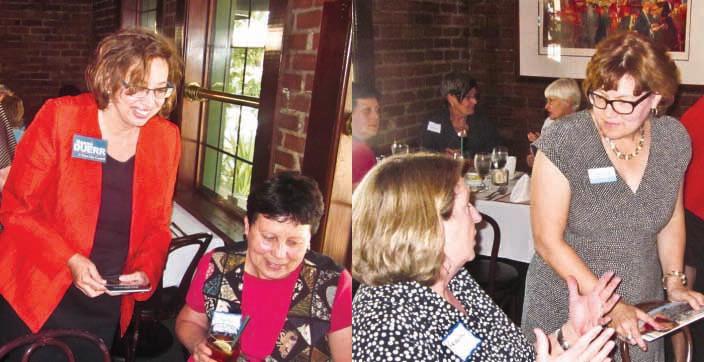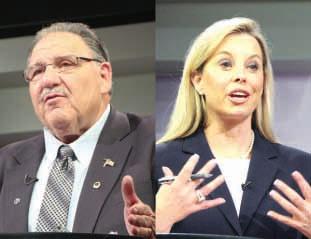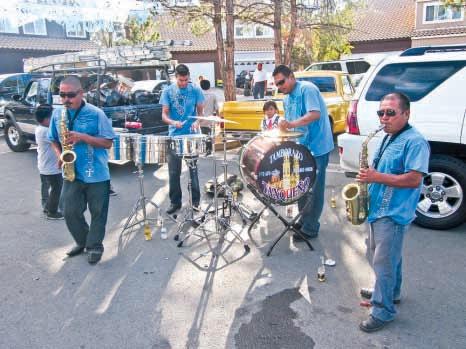
12 minute read
News
from Oct. 16, 2014
Repeal still to come
The fate of marriage equality in Nevada may be settled, but there is a lingering legal matter that still must be dealt with—the now-obsolete language in the Nevada Constitution.
Advertisement
Article 1, section 21 of the constitution reads, “Only a marriage between a male and female person shall be recognized and given effect in this state.” That language was added by a vote of the public after an initiative petition put the issue on the ballot in 2000. In first round voting that year, Nevadans voted 69.6 to 30.3 percent for the change. In second round voting in 2002, it was 67.2 to 32.7 percent in favor.
But in Nevada as elsewhere, change came relatively rapidly. Opinion surveys showed a steady decline in support for the ban—by August 2011, according to a Public Policy Polling survey, the state was in a virtual tie, 45 percent supporting marriage equality, 44 percent opposing it. By February 2013, according to a Public Opinion Strategies survey commissioned by the Retail Association of Nevada, 54 percent of Nevadans supported repealing the ban, 43 percent opposed it.
As that survey was released, the Nevada Legislature was already processing a measure—Senate Joint Resolution 13 of the 2013 legislature—to let the public vote on the issue. While initiative petitions must be voted on by the public twice, constitutional changes initiated by the lawmakers must pass the Legislature twice and be voted on by the public once. So SJR 13 must still be approved by the 2015 legislative session and then voted on by the public in 2016.
There is precedent. In 1992, the Legislature placed a measure on the ballot providing for removal of constitutional language that barred black men and former slaves from voting, a change that had already been accomplished by federal action.
Somewhat presumptuously, the legislative legal staff has already inserted the proposed but unapproved marriage language into the semi-official and supposed authoritative online copy of the Nevada Constitution, so both the original ban and the conflicting proposed repeal language now appear side by side.
Book discredited by scrutiny
The Columbia Journalism Review, a journal that covers ethical issues, has called on the CBS-owned publishing firm Simon and Schuster to destroy all stocks of a book on Marilyn Monroe and Joe DiMaggio that deals in part with their activities in Nevada. The book, Joe and Marilyn, was written by C. David Heymann, a now-deceased author. One of his previous books, a biography of Barbara Hutton, was exposed as a fraud in the Los Angeles Times, and 58,000 copies were destroyed by Random House. His books had a suspicious habit of relying for information on deceased sources.
In its Aug. 27 edition, Newsweek carried a David Cay Johnston article raising serious questions about the reliability of Joe and Marilyn. Johnston wrote that Heymann “cites Joe DiMaggio Jr. … as a source on more than 50 of the book’s 393 pages. Joe Jr. died in 1999, long before Heymann started work on the book, and he routinely turned reporters away. Public records contradict many of the quotes attributed to him in the book.”
“[A]ll the celebrity bios Heymann wrote [for CBS] are riddled with errors and fabrications,” Johnston wrote, questioning why CBS keeps publishing them and urging teachers to use them.
Joe and Marilyn touches on Nevada aspects of both of the celebrities’ lives, and of other figures associated with them—Monroe during the filming of the Nevada movie The Misfits, playwright Arthur Miller’s stay at the Pyramid Lake Guest Ranch to establish divorce residency so he could marry Monroe, Dorothy DiMaggio’s 1942 visit to Reno to start divorce proceedings, Monroe’s 1946 Las Vegas divorce from Jim Dougherty, and other Nevada items.
At one point, Heymann writes, “Miller and Monroe shared a two-bedroom suite at the Mapes Hotel and Casino in Reno; their marriage in tatters, they occupied separate rooms and were rarely seen together. When they were seen together, the spectacle wasn’t always pretty. Monroe delighted in humiliating and embarrassing her husband before cast and crew alike.” While Monroe had a Mapes suite for greeting visitors and other ceremonial purposes, she had a hideaway elsewhere in the city where she stayed. Naomi Duerr and Elisa Cafferata hustled for votes last month at a luncheon meeting of the Nevada Women’s Lobby.
Water fight
Council candidates bring different approaches
Elisa Cafferata and Naomi Duerr may clash in their race for Reno City Council, by but they still have very similar interDennis Myers ests—particularly water. Duerr ran the Flood Project Coordinating Committee (now the Flood Management Authority) for six years, after serving as state water planner. Cafferata was a management analyst for seven years at the Regional Planning Agency and director of Truckee Meadows Tomorrow, a private organization that focuses on quality of life.
Naomi Duerr reno City Council candidate
“Water planning work, and really the local governments and the way they plan our communities, has a lot of impact on our quality of life,” Cafferata said.
Cafferata also has a considerable history in community organizing. In 1994 Oregon activist Lon Mabon, who succeeded in passing an anti-gay initiative petition in his state, then tried the same thing in adjoining states, including Nevada. The climate of opinion was very different in that year than it is now—hostile to gays. Cafferata put together a campaign to block the Mabon effort, recruiting both Democrats and Republicans—including her grandmother, U.S. Rep. Barbara Vucanovich, and her mother, former GOP nominee for governor Patty Cafferata. Casinos concerned about a gay boycott of Nevada joined the effort. Mabon failed to get enough signatures to qualify for the ballot.
“I also grew up around a family that lived public service, and I saw the good work that my mother and my grandmother were able to do,” she said. “The thing about local government is that it is where people live. It’s the place where you can make the most difference.”
As for water, “There are a couple of things I’m really interested in,” she said. “Making sure that we plan for the best sustainable approach to water. And I work downtown at the Reno Collective”—a technology workspace business—“and tech jobs are what drive economic growth in cities. And it’s not just technology jobs but all of the support industries and people that come with that.”’
She does, in fact, mention terms like technology and innovation at every opportunity. She also said one part of city government needs change.
“Redevelopment is going to have to be redesigned because the redevelopment agency doesn’t have any funds to do new work,” she said. “They just need to pay off the debts they’ve incurred. So we need a new approach to redevelopment.”
She said quality of life is key to the city’s success.
“I think my campaign theme is really about smart government, looking at the long term to make communities that people want to live in and raise their families in.”
Consensus
The Reno News & Review reported in 2006, “Naomi Duerr is one of two local officials who carry the area’s institutional knowledge of Truckee River flood control around in their heads” (“Flood money,” Feb. 23, 2006). So Cafferata, in emphasizing water, is facing a heavyweight.
Cafferata’s family heritage gave her a comfort level with politics. Duerr, though involved in public service, is less at home with the hailfellow-well-met aspect of campaigning. For her, issues are everything. But she says her experience with the water agency gave her the kind of experience she will need to work with six other councilmembers. Here’s why: On the flood agency board, a single “no” vote could stop any initiative. The board was made up of two Reno members, two Sparks members, and two Washoe County members, whose governments could not normally agree on lunch. All actions required unanimous votes, and “I was able to accomplish 500 unanimous votes,” Duerr said.
In addition, because the flood agency had to set up all its actions and contracts through a local government—the county—she had to know how to work well with a competing entity, she said.
“I build consensus, and then I go get things done,” she said.
While the race has been relatively polite, one clash that irritated Duerr was an attack over the flood agency. “If you have such a sharp pencil, how is it that the flood project budget grew to $1.6 billion [when Duerr was director]?” Cafferata asked during a debate with Duerr.
While Cafferata’s question attracted attention and won her points for debating skills, Duerr said no one provided background on where the figures came from.
The Army Corps of Engineers regularly updates cost estimates on flood plans it participates in to keep figures current with inflation. In this case, Duerr said, the Corps re-costed essentially the same project three times in six years. Estimates went from $350 million to $800 million to $1.6 billion. Duerr’s role was informing the Coordinating Committee and the public of the changes.
“My opponent actually participated in developing that plan,” she said. “She knows what happened. They [the Corps] re-costed everybody’s plan in America, and everyone doubled.”
When she handled a project on her own—restoring several areas of the river—she said she was able to bring it in at about $20 million locally even though the Corps had estimated the project at $90 million. “I was able to get the Reno Sparks Indian Colony and the state of Nevada to give land,” she said. “And $2.2 million came from Walmart,” which was building a store in one of the affected areas.
The two candidates both argue in favor of the town/gown initiative currently being advocated by local powerbrokers to promote Reno as a “university town.”
“The communities that are invested in education are doing better in the economic recovery,” Cafferata said. “We need to invest in education and innovation—and not just in the university but in tech startups and local companies.”
“I think we all could benefit from that,” Duerr said. “The community could benefit. The students could benefit.”
Ward 2 runs from West Plumb Lane on its north end to the area around the Mt. Rose/Virginia City intersestion in the south, including a lot of industrial and shopping areas and relatively affluent residential neighborhoods that are fairly compact and thus easy to campaign in door-to-door. Ω

Elisa Cafferata City council candidate
Neighbors

On Merchants Street in Sparks, Tamborazo Taxqueno played for an old fashioned neighborhood party. Dozens of people, mostly families, attended the festive gathering.
The next mayor
As far as the law is concerned, Reno’s next mayor will be nothing more than a glorified City Council member, give or take a few ceremonial duties—the result of a Nevada Supreme Court ruling that the mayor is just a member of the City Council with a better title. But ask mayoral candidates Ray Pezonella and Hillary Schieve what they think of the position, and you’ll get a much different answer. “The mayor is the mayor,” said Pezonella, a longtime civil engineer and establishment favorite to replace outgoing mayor Bob Cashell. “That is the statesman, that is the figurehead, that’s the voice, the person that people want to come see.” “The mayor truly sets the tone and the culture of the city,” said Schieve, a sitting city councilmember and small-business owner. But in a rapidly changing economic environment, the shift away from a gambling-centered economy and the looming impact of Tesla means the next mayor will not only play a leadership role in local affairs, but will also symbolize what direction the city takes over the next four years. “I think [the election is] more a referendum on how the city is changing, economically and demographically,” UNR political science professor Eric Herzik said. “I’m not seeing a historical parallel,” he added. “It’s uncharted territory.” Given their age and gender differences, Pezonella and Schieve come from surprisingly similar backgrounds. Both are business owners sporting high-profile endorsements, and relative newcomers to the political scene. (Schieve was elected to the Reno City Council two years ago.) And both candidates tend to agree on most of the issues—subtract a few
quibbles about fire staffing levels and public benefit restructuring, and by Schieve and Pezonella differ only Riley Snyder slightly in terms of policy. The real decision for voters, then, comes in the form of what sort of mayoral style they prefer. Is it the more status-quo Pezonella, backed by traditional power brokers, or the “fresh face” of Schieve? Despite her status as a sitting city councilmember, Schieve is in several ways running as an outsider candidate. With local city power brokers—development and construction leaders—first throwing their weight behind Pezonella, Schieve’s campaign has sought out younger and more diverse voters than would usually be expected in a mayoral race. “I always run like I’m in last place,” she said. A first-time political candidate, Pezonella nevertheless counts endorsements from numerous Reno businesses and outgoing Reno mayor Bob Cashell. Though it is somewhat odd that a political newbie is running as an establishment candidate, Pezonella’s primary focus as mayor would be to reduce the city’s multimillion dollar debt. “I’m not looking for new ways to spend money,” he said. “I’m looking for ways to get our debt paid.” Though Schieve won the primary election with 26 percent of the vote, that election was somewhat skewed by the number of candidates—18, one of them dead—running for mayor. Pezonella, who won 18 percent of the vote, said he’s confident that he’ll be able to make up the difference by election day. But Herzik doesn’t hedge his bets when it comes to predicting who will win the race. “I’ll be surprised if Schieve doesn’t win,” he said. Though Herzik credits Pezonella as a quality candidate, his prediction for a Schieve victory is based on her victory in the primaries, appeal to a more diverse electorate, and an energetic campaign. Though both campaigns declined to share internal polling numbers, Herzik said Pezonella’s chances improve with lower turnout. In a nonpresidential year lacking dramatic statewide races, it could be easier for more conservative and older populations that support Pezonella to dominate at the polls. Schieve has raised four dollars for every six raised by Pezonella— $80,530.10 to $131,700. “With low voter turnout, anything can happen,” Schieve said. Ω
Photo/Dennis Myers
Mayoral candidates Ray Pezonella, left, and Hillary Schieve couldn’t look more different, but their policies and contributors look very similar.










